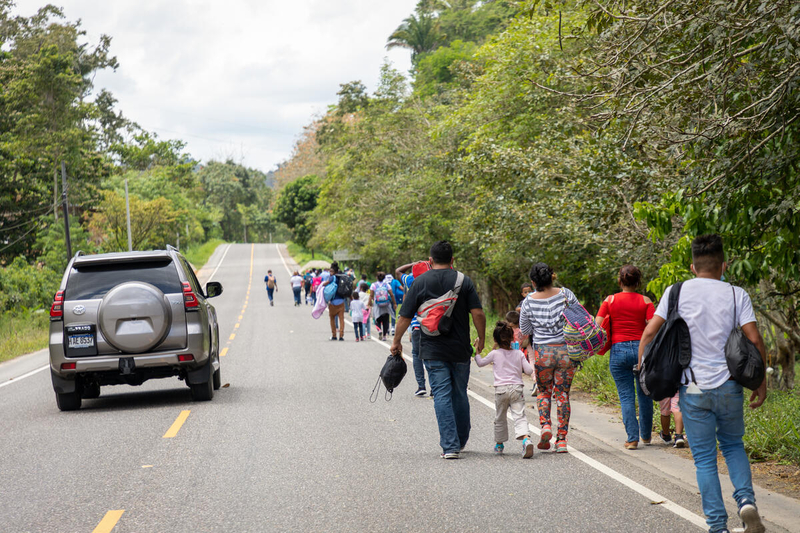Barren Farms, Violent Crime and No Jobs. Here’s What Most of Us Don’t Know About Migration

Today, the global spotlight is shining brightly on the Central American migration crisis. A recent visit by Vice President Kamala Harris and the ongoing challenges of the COVID-19 pandemic have intensified that attention, leaving many to question what the root causes are of the migration. We have some answers, and they all boil down to one thing: hunger.
Hundreds of thousands of Central Americans have been battered and bruised by COVID-19, climate change and the resulting hunger. They’ve been forced into the only available option: to leave home in search of food and a better life. In March of 2021, 172,000 migrants were recorded attempting to cross the border into the United States — a 71 percent increase compared just to the previous month.
“There are no easy solutions to untangle America’s complex border challenges, but there are remedies that can alleviate vulnerable people’s need to migrate. They begin with understanding what truly drives the hunger that prompts so many people to leave their homes,” said President and CEO of WFP USA, Barron Segar.
In the last two years, hunger in El Salvador, Guatemala, Honduras and Nicaragua has almost quadrupled – from 2.2 million people in 2018 to nearly 8 million people today. It is no coincidence that we are seeing a startling rise in migration out of the region.
Let’s take a closer look at the three main drivers of hunger in Central America today.
1) The Ceaseless Effects of Climate Change
Extreme weather events are one of the leading causes of migration out of Central America. Take Hurricanes Eta and Iota for example. When the back-to-back storms hit (the strongest ones in recorded history for late season), nearly 7 million people lost their homes. Thousands of acres of farmland were destroyed, homes washed away and food supplies were devastated.
In a cruel irony, five years of consecutive drought in Honduras have turned once-fertile farmland into barren dust. For those who depend on one good harvest per year, this drought has depleted their food supplies and forced them to sell valuable possessions (including farming tools and livestock) to buy food and feed their families.

Years of drought have left soil in the Dry Corridor barren and vulnerable to fires. In a region where most of the population relies on agriculture, this severe drought has worsened hunger and forced many to migrate.
2) Violence and Crime on Their Doorsteps
El Salvador, Guatemala and Honduras are exceptionally dangerous places to live. With high rates of domestic violence and gang recruitment, nearly one-fifth of families migrate because of violence on their streets.

In March of 2021, about one hundred Guatemalan migrants began their journey on foot to reach the U.S. border. To keep their loads light, families carry small bags with bare minimum supplies: a few clothes, pasta, one bottle of water, medicine and sanitary items.
In all its forms, conflict is the number one cause of hunger around the world. Violence cuts people off from their food supplies, takes their jobs and ruins economies. When conflict becomes unbearable or deadly, most people have no choice but to leave home. They then often find themselves without adequate shelter, medical supplies, electricity, money or food.
3) Economic Vulnerability
Even before the COVID-19 pandemic hit, Honduras was one of the poorest countries in the Western Hemisphere and healthy, staple foods were out of reach for many. Today, the number of households in Guatemala and Honduras that do not have enough to eat has doubled because of COVID-19-induced recessions and job losses.

Erick has a degree in agronomy and planned to continue in agricultural engineering, but he couldn’t afford it. Instead, he works a six-month seasonal job picking melons in the heart of the Dry Corridor and does not know how he will earn a living once it ends. He feels hopeless and wants to migrate so his son Dilan will have better opportunities and be safe from nearby gangs.
“Urban and rural communities in Central America have hit rock bottom,” said Miguel Barreto, U.N. World Food Programme Regional Director for Latin America and the Caribbean. “The COVID-19-induced economic crisis had already put food on the market shelves out of reach for the most vulnerable people when the twin hurricanes Eta and Iota battered them further.”
Holding Out Hope
It is not only life-or-death factors that drive migrants to leave. For many, it’s the hope of:
- reuniting with family members who have already made the journey
- having a home safe from drought and erratic rainfall
- being safe from gangs and domestic violence
- finding a job with a stable income
These human instincts pull families out of their home countries and towards a brighter future, one where their children can go to bed safely with a full belly of food each night.
Looking at the root causes of Central American migration pulls back the curtain on what the movement truly is for many: a journey home.
For those facing violence and climate change on their doorsteps, home is no longer where their family built their livelihoods but wherever they can be reunited with loved ones and wake up secure in the knowledge that sons and daughters are sleeping safely under one roof.
After years of hardship, who among us would not risk everything for the chance at that life?




